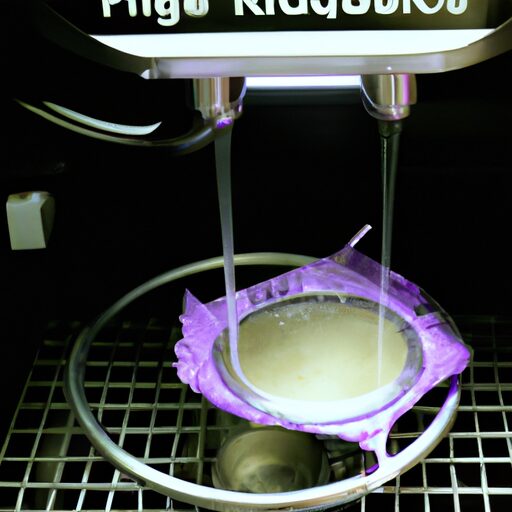
Are you tired of your commercial Keurig coffee machine producing lackluster cups of joe? Well, we’ve got the solution for you! In this article, we will share with you some simple and effective tips on how to clean your commercial Keurig coffee machine to ensure that it consistently delivers delicious and high-quality brews. From descaling to deep cleaning, we’ve got you covered. Get ready to say goodbye to mediocre coffee and hello to a perfectly functioning Keurig machine!
Preparing for Cleaning
Gathering the necessary supplies
Before starting the cleaning process for our commercial Keurig coffee machine, it is essential to gather all the necessary supplies. We will need a cleaning solution specifically designed for descaling coffee machines, a soft cloth or sponge, warm water, a toothbrush or small brush for scrubbing, and a dry towel for drying.
Turning off and unplugging the machine
For safety purposes, the first step in preparing to clean our Keurig coffee machine is to turn off and unplug the machine. This will prevent any electrical accidents during the cleaning process and ensure that we can work on the machine without any disruptions.
Allowing the machine to cool down
Before starting the cleaning process, we must allow the machine to cool down completely. The hot components can pose a burn risk, so it’s important to ensure that the machine has reached a safe temperature before proceeding with the cleaning.
Emptying and removing the water reservoir
To clean the water reservoir effectively, we need to empty it and remove it from the machine. Carefully detach the water reservoir from the machine, making sure to follow the manufacturer’s instructions to avoid any damage.
Emptying and removing the K-Cup holder
To thoroughly clean the K-Cup holder, we need to empty it first. Remove any used or remaining K-Cups from the holder and discard them. Once empty, detach the K-Cup holder from the machine according to the manufacturer’s instructions. It’s important to handle the K-Cup holder with care to avoid any damage.
Cleaning the Water Reservoir
Disassembling the reservoir
To clean the water reservoir, we need to disassemble it carefully. Remove any detachable parts, such as the lid or filter holder, if applicable. Refer to the manufacturer’s instructions for any specific disassembly steps required for your specific Keurig model.
Cleaning the exterior
Start by cleaning the exterior of the water reservoir. Dampen a cloth or sponge with warm water and a mild detergent, such as dish soap. Gently wipe down the exterior surface of the reservoir, removing any dirt or stains. Pay attention to the corners and crevices, ensuring that all areas are thoroughly cleaned.
Cleaning the interior
To clean the interior of the water reservoir, use a solution of warm water and descaling solution. Follow the manufacturer’s instructions for diluting the descaling solution properly. Use a soft brush or toothbrush to scrub the interior surfaces, paying special attention to any hard-to-reach areas.
Rinsing and drying the reservoir
Once the interior surfaces of the water reservoir have been cleaned, thoroughly rinse it with clean water. Make sure to remove all traces of the cleaning solution and any debris. After rinsing, dry the reservoir completely with a clean towel or allow it to air dry before reassembly.
Cleaning the K-Cup Holder and Assembly
Disassembling the K-Cup holder
Before cleaning the K-Cup holder and assembly, we need to disassemble it. Refer to the manufacturer’s instructions to understand how to properly dismantle the K-Cup holder. Remove any detachable parts, such as the funnel or filter, if applicable.
Cleaning the K-Cup holder and assembly
Using warm soapy water and a soft brush or toothbrush, gently scrub the K-Cup holder and assembly. Pay attention to any buildup or residue that may have accumulated. This step helps remove any coffee oils or debris that may affect the machine’s performance.
Cleaning the exit needle
The exit needle is a crucial part of the K-Cup holder that can become clogged over time. To ensure optimal performance, we need to clean the exit needle properly. Use a small brush, like a toothbrush, to carefully clean the needle. Make sure to remove any residue or clogs that may hinder the flow of water.
Reassembling the K-Cup holder and assembly
Once the cleaning process is complete, it’s time to reassemble the K-Cup holder and assembly. Carefully put back all the detachable parts in their correct positions, following the manufacturer’s instructions. Ensure a snug fit to prevent any leakage or improper functioning.
Descaling the Machine
Understanding the importance of descaling
Descaling is a crucial step in maintaining the performance and longevity of our Keurig coffee machine. Over time, mineral deposits from the water can accumulate and affect the machine’s functionality. Descaling helps remove these deposits and ensures optimal brewing results.
Choosing a descaling solution
When selecting a descaling solution, it is important to use a product specifically designed for coffee machines. Avoid using vinegar or other acidic substances, as they can potentially damage the internal components of the machine. Follow the manufacturer’s recommendations for the best descaling solution to use.
Preparing the descaling solution
Prepare the descaling solution according to the manufacturer’s instructions. Dissolve the descaling solution in water, ensuring the proper ratio for your Keurig model. Be mindful of the safety measures provided by the manufacturer, such as wearing gloves or working in a well-ventilated area.
Running a descaling cycle
Once the descaling solution is ready, it’s time to run a descaling cycle with our Keurig machine. Place an empty container or cup on the drip tray to capture the solution. Follow the specific instructions for initiating the descaling cycle on your Keurig model. Allow the machine to complete the cycle, ensuring that all the solution passes through the internal components.
Rinsing the machine
After completing the descaling cycle, it is crucial to rinse the machine thoroughly. Run multiple cycles of clean water through the machine to remove any residue or leftover descaling solution. This step helps to ensure the removal of any taste or odor that may be present. Once rinsed, the Keurig machine is now ready to use.
Cleaning the Drip Tray and Drip Tray Plate
Removing the drip tray and plate
To clean the drip tray and drip tray plate, we need to remove them from the Keurig machine. Carefully detach the drip tray and plate, following the manufacturer’s instructions. Empty any liquid or debris collected in the drip tray.
Cleaning the drip tray and plate
Using warm soapy water and a soft cloth or sponge, clean the drip tray and plate thoroughly. Pay attention to removing any coffee stains or residue that may have accumulated. For stubborn stains, a gentle scrub with a toothbrush can be effective.
Drying and reassembling the drip tray and plate
After cleaning, ensure that the drip tray and plate are completely dry before reassembling them. Use a clean towel or allow them to air dry. Once dry, carefully reattach the drip tray and plate to the Keurig machine, making sure they are securely in place.
Cleaning the Exterior
Choosing a cleaning solution
When cleaning the exterior of our Keurig coffee machine, it is important to choose a cleaning solution suitable for the material. Avoid abrasive cleaners that may damage or scratch the surface. If unsure, opt for a mild dish soap mixed with warm water.
Damping a cloth or sponge
Dampen a soft cloth or sponge with the chosen cleaning solution. Make sure to squeeze out any excess liquid to avoid dripping onto the machine, which could potentially cause damage.
Wiping down the exterior
Gently wipe down the exterior of the Keurig machine, paying attention to any areas with visible dirt, fingerprints, or stains. Use a gentle circular motion and take care around buttons or sensitive areas. Regular cleaning of the exterior helps maintain the machine’s appearance and prevents the buildup of grime.
Cleaning the display and buttons
To clean the display and buttons, use a gentle touch to avoid scratching or damaging the surfaces. Dampen a cloth or sponge with the cleaning solution and wipe down the display and buttons carefully. Avoid submerging the display or using excessive liquid that may seep into the internal components.
Cleaning the Brewer Head and Exit Needle
Removing the K-Cup holder
Before cleaning the brewer head and exit needle, we must remove the K-Cup holder. Follow the manufacturer’s instructions for proper removal to avoid any damage.
Cleaning the brewer head
Using warm soapy water and a soft brush, clean the brewer head carefully. Pay attention to any visible residue or buildup that may affect the machine’s performance. Gently scrub the brewer head to remove any lingering oils or debris.
Cleaning the exit needle
The exit needle is a critical component of the brewer head that may become clogged over time. To clean the exit needle, use a small brush, such as a toothbrush, and gently scrub the needle. This will help remove any coffee grounds or residue that may hinder the flow of water during brewing.
Reassembling the K-Cup holder
After the cleaning process is complete, it’s time to reassemble the K-Cup holder. Carefully place the K-Cup holder back into the machine, ensuring a secure fit. Follow the manufacturer’s instructions to ensure proper alignment and avoid any leaks or malfunctions.
Cleaning the Water Line
Removing the water line
To clean the water line, we need to remove it from the Keurig machine. Follow the manufacturer’s instructions to understand how to properly detach the water line. Take caution not to apply excessive force or damage any connectors.
Cleaning the water line
Using warm soapy water and a soft brush or sponge, clean the water line thoroughly. Pay attention to any visible buildup or debris that may affect the machine’s water flow. If necessary, use a toothbrush for hard-to-reach areas or stubborn stains. Ensure all parts of the water line are cleaned and rinsed properly.
Reattaching the water line
After cleaning the water line, carefully reattach it to the Keurig machine following the manufacturer’s instructions. Ensure a secure connection to avoid any leaks or water flow issues. Double-check that all connections are properly tightened before moving on to the next step.
Cleaning the Pod Holder Assembly
Removing the assembly
To clean the pod holder assembly, we need to remove it from the Keurig machine. Follow the manufacturer’s instructions to understand how to properly detach the assembly. Take care not to damage any connectors or apply excessive force.
Cleaning the pod holder assembly
Using warm soapy water and a soft brush or sponge, clean the pod holder assembly thoroughly. Pay attention to any residue or buildup that may have accumulated and could affect the machine’s performance. A toothbrush can be helpful for scrubbing hard-to-reach areas or stubborn stains.
Reassembling the pod holder assembly
Once the cleaning process is complete, it’s time to reassemble the pod holder assembly. Carefully align all the parts and connectors according to the manufacturer’s instructions. Ensure a secure fit to prevent any leakage during brewing. Take care not to over-tighten any screws or connectors.
Cleaning the Cup Sensor
Locating the cup sensor
The cup sensor is a small, important component of the Keurig machine that detects the presence of a cup during brewing. Locate the cup sensor, usually found near the brewer head or on the machine’s drip tray.
Cleaning the cup sensor
Clean the cup sensor with a soft cloth or sponge dampened with warm soapy water. Gently wipe down the sensor area, removing any visible dirt or residue that may affect its functionality. Take caution not to press too firmly to avoid damaging the sensor.
Wiping down the cup sensor area
After cleaning the cup sensor, wipe down the surrounding area to ensure a thorough cleaning. Use a clean, damp cloth to remove any remaining cleaning solution or debris. This step helps to maintain the cleanliness of the cup sensor area and promotes optimal performance.
By following these comprehensive cleaning steps, we can ensure that our commercial Keurig coffee machine remains in excellent condition, providing us with fresh and flavorful coffee every day. Regular cleaning and maintenance are essential to prolong the lifespan of the machine and optimize its brewing performance. With a little time and effort invested in proper cleaning, we can continue to enjoy the convenience and deliciousness of our Keurig coffee machine for a long time to come.






